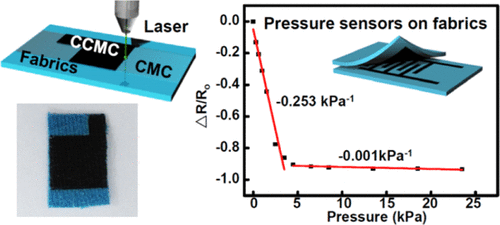当前位置:
X-MOL 学术
›
ACS Appl. Electron. Mater.
›
论文详情
Our official English website, www.x-mol.net, welcomes your
feedback! (Note: you will need to create a separate account there.)
Mask-Free Preparation of Patterned Carbonized Carboxymethyl Cellulose on Fabrics for Flexible Electronics
ACS Applied Electronic Materials ( IF 4.3 ) Pub Date : 2020-03-04 , DOI: 10.1021/acsaelm.0c00084 Yue Miao 1 , Lijia Wan 2 , Xiaofeng Ling 3 , Bo Chen 4 , Likun Pan 2 , Yang Gao 1
ACS Applied Electronic Materials ( IF 4.3 ) Pub Date : 2020-03-04 , DOI: 10.1021/acsaelm.0c00084 Yue Miao 1 , Lijia Wan 2 , Xiaofeng Ling 3 , Bo Chen 4 , Likun Pan 2 , Yang Gao 1
Affiliation

|
Fabric-based flexible electronics have promising applications in biomedicine, soft robots, and human–machine interfaces. However, fabrication of flexible electronics on fabrics in a high throughput and scalable manner without significantly sacrificing the benefits of fabrics is still a challenge. To address this, a laser direct writing (LDW)-based technique is developed for the mask-free fabrication of flexible electronics on fabrics. Carboxymethyl cellulose (CMC) is chosen as the precursor for the carbon electrode formed by LDW on the fabrics because CMC is water soluble, which is convenient to be processed and able to be mixed with inorganic precursors to form composites. Flexible pressure sensor based on LDW-carbonized CMC (CCMC) has a sensitivity of −0.25 kPa–1 within 5 kPa, response time of 0.5 s, and detectable limit of 140 Pa. The specific capacitance of the LDW prepared MoxOy/CCMC electrode is 12.8 mF/cm2. The LDW MoxOy/CCMC composite-based flexible all-solid-state supercapacitor has a capacitance of 1.095 mF/cm2, with a high flexibility and mechanical durability.
中文翻译:

柔性电子织物上无掩模图案化碳羧甲基纤维素的无掩模制备
基于织物的柔性电子产品在生物医学,软机器人和人机界面中具有广阔的应用前景。然而,在织物上以高产量和可扩展的方式制造柔性电子器件而不显着牺牲织物的益处仍然是一个挑战。为了解决这个问题,开发了基于激光直接写入(LDW)的技术,用于在织物上无掩模地制造柔性电子产品。羧甲基纤维素(CMC)被选为LDW在织物上形成碳电极的前驱体,因为CMC是水溶性的,它易于加工并且能够与无机前驱体混合形成复合材料。基于LDW碳化CMC(CCMC)的柔性压力传感器的灵敏度为-0.25 kPa –1在5 kPa内,响应时间为0.5 s,可检测极限为140 Pa。LDW制备的Mo x O y / CCMC电极的比电容为12.8 mF / cm 2。基于LDW Mo x O y / CCMC复合材料的柔性全固态超级电容器的电容为1.095 mF / cm 2,具有很高的柔性和机械耐久性。
更新日期:2020-04-23
中文翻译:

柔性电子织物上无掩模图案化碳羧甲基纤维素的无掩模制备
基于织物的柔性电子产品在生物医学,软机器人和人机界面中具有广阔的应用前景。然而,在织物上以高产量和可扩展的方式制造柔性电子器件而不显着牺牲织物的益处仍然是一个挑战。为了解决这个问题,开发了基于激光直接写入(LDW)的技术,用于在织物上无掩模地制造柔性电子产品。羧甲基纤维素(CMC)被选为LDW在织物上形成碳电极的前驱体,因为CMC是水溶性的,它易于加工并且能够与无机前驱体混合形成复合材料。基于LDW碳化CMC(CCMC)的柔性压力传感器的灵敏度为-0.25 kPa –1在5 kPa内,响应时间为0.5 s,可检测极限为140 Pa。LDW制备的Mo x O y / CCMC电极的比电容为12.8 mF / cm 2。基于LDW Mo x O y / CCMC复合材料的柔性全固态超级电容器的电容为1.095 mF / cm 2,具有很高的柔性和机械耐久性。











































 京公网安备 11010802027423号
京公网安备 11010802027423号